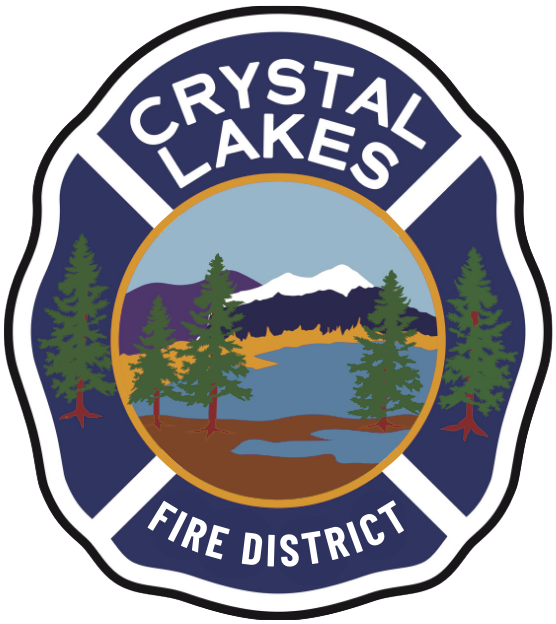National Fire Danger Rating System
Have you ever entered a national forest and seen a sign indicating today's fire danger levels?
It's one way national forest fire managers can quickly alert visitors about fire danger. Because these fire danger levels are specific to an area, the levels aren't posted here on this website. Watch for the signs (see sample below) along forest roads and entrances, visitor recreation areas or ranger stations or contact your Local, State, or Federal fire agency(s), to get the official Fire Danger Rating. Knowledge of these levels can help forest visitors make decisions about having a campfire. Contractors working in the forest may consider extra precautions (like having a lookout) when using equipment that might produce sparks. In some cases, the National Forest may restrict or ban certain activities based on the fire danger levels.
What is the National Fire Danger Rating System?
The National Fire Danger Rating System (NFDRS) is a system that allows land agencies to estimate today’s or tomorrow’s fire danger for a given area. It integrates the effects of existing and expected states of selected fire danger factors into one or more qualitative or numeric indices that reflect an area’s fire protection needs. It links an organization’s readiness level (or pre-planned fire suppression actions) to the potential fire problems of the day. The symbols and adjectives shown below are to alert the public of fire danger levels, using adjectives and colors based on criterial established by the National Fire Danger Rating System.
The goal is to encourage the public to adapt their behavior and obey restrictions based on their knowledge of these levels.
IGNITION: A rating of the probability that a firebrand will cause an actionable fire.
SPREAD: A rating of the forward rate of spread of the head of a fire.
SPOTTING: Behavior of a fire producing sparks or embers that are carried by the wind and which start new fires beyond the zone of direct ignition by the main fire.
CONTROL: The completion of control line around a fire, any spot fires therefrom, and any interior islands to be saved; burned out any unburned area adjacent to the fire side of the control lines; and cool down all hot spots that are immediate threats to the control line, until the lines can reasonably be expected to hold under the foreseeable conditions.
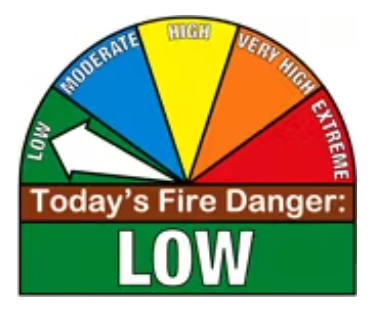
IGNITION: Fuels do not ignite readily from small firebrands although a more intense heat source, such as lightning, may start fires in duff or dry rotted wood.
SPREAD: Fires in open cured grasslands may burn freely a few hours after rain, but woods fires spread slowly by creeping or smoldering, and burn in irregular fingers.
SPOTTING: There is little danger of spotting.
CONTROL: Control of fires is generally easy.
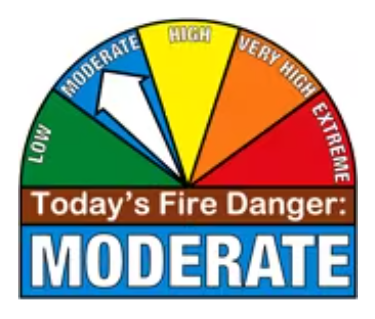
IGNITION: Fires can start from most accidental causes, but with the exception of lightning fires in some areas, the number of starts is generally low.
SPREAD: Fires in open cured grasslands will burn briskly and spread rapidly on windy days. Timber fires spread slowly to moderately fast. The average fire is of moderate intensity, although heavy concentrations of fuel, especially draped fuel, may burn hot.
SPOTTING: Short-distance spotting may occur, but is not persistent.
CONTROL: Fires are not likely to become serious and control is relatively easy.
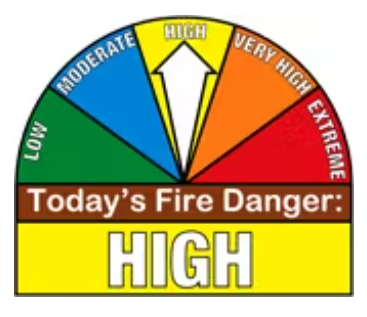
IGNITION: All fine dead fuels ignite readily and fires start easily from most causes. Unattended brush and campfires are likely to escape.
SPREAD: Fires spread rapidly. High-intensity burning may develop on slopes or in concentrations of fine fuels.
SPOTTING: Short-distance spotting is common.
CONTROL: Fires may become serious and their control difficult unless they are attacked successfully while small.
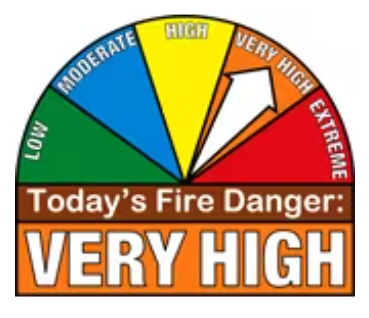
IGNITION: Fires start easily from all causes.
SPREAD: Immediately after ignition, spread rapidly and increase quickly in intensity. Fires burning in light fuels may quickly develop high intensity characteristics such as long-distance spotting and fire whirlwinds when they burn into heavier fuels.
SPOTTING: Spot fires are a constant danger; long distance spotting likely.
CONTROL: Fires can be difficult to control and will often become much larger and longer-lasting.
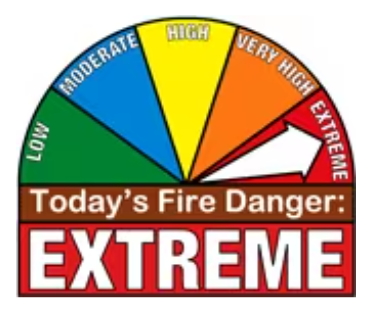
IGNITION: Fires start quickly and burn intensely. All fires are potentially serious.
SPREAD: Furious spread likely, along with intense burning. Development into high intensity burning will usually be faster and occur from smaller fires than in the very high fire danger class.
SPOTTING: Spot fires are a constant danger; long distance spotting occurs easily.
CONTROL: Direct attack is rarely possible and may be dangerous except immediately after ignition. Fires that develop headway in heavy slash or in conifer stands may be unmanageable while the extreme burning condition lasts. Under these conditions the only effective and safe control action is on the flanks until the weather changes or the fuel supply lessens.
What do you mean by “fire danger?”
Fire danger is the resulting description of the combination of both constant and variable factors which affect the initiation, spread, and difficulty of control of wildfires on an area.
What fire danger factors are used to get this rating?
Fuels, weather, topography, and risks are key inputs into the model.
How is fire danger different than fire behavior predictions?
Fire danger is a broad scale assessment while fire behavior is site specific. Fire danger ratings describe conditions that reflect the potential, over a large area, for a fire to ignite, spread and require suppression action. Fire behavior deals with an existing fire in a given time and space. It describes the movement, intensity, and indicators of rapid combustion of an ongoing fire.
What do you mean by Adjective Rating?
Adjective Ratings are a public information description of the relative severity of the current fire danger situation in a general area. The National Fire Danger Rating System helps management agencies to determine this level. Adjective Ratings are generally posted on signs as visitors enter public lands or at agency offices. Many people associate these signs as “Smokey Bear signs”.
What are the different levels (or adjective ratings) and what do they mean?
We use 5 different color coded levels to help the public understand fire potential. The purpose of this is for visitors to understand the current conditions and help mitigate their actions to prevent catastrophic human-caused wildfires. (Some visitors have even reported their fire prevention actions when other forest visitors have been negligent; such as putting out an abandoned campfire.)
